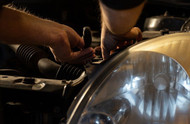How to Diagnose a Coolant Leak
17th Jun 2021

Is your vehicle leaking coolant? Regardless of the temperature outside, you won't be able to drive your car very long if it's leaking coolant. Coolant is responsible for removing heat from the engine so that it doesn't warp or otherwise fail. With a coolant leak, your vehicle's engine may overheat -- even if it's cold outside. Fortunately, you can often diagnose a coolant leak by performing a few simple inspections.
Look Around the Radiator Cap
With the hood open, look around the radiator cap to see if there's any liquid present. While coolant leaks can occur in many different places, the radiator cap is one of the most common. All radiators have a cap that fits over the filler neck. To refill your radiator with more coolant, you'll have to open this cap (don't open the radiator cap while the engine is hot or warm). Radiator caps, of course, can leak. As the lip seal degrades, it may cause coolant to leak out from between the radiator cap and the radiator filler neck.
Check the Hoses
Assuming there's no visible fluid around the radiator cap, you should check your vehicle's radiator hoses. Radiator hoses are rubber hoses that run from the radiator to the engine. There are usually two radiator hoses: one that sends coolant from the engine to the radiator, and another hose that sends coolant from the radiator to the engine. With the engine cold, check the coolant hoses for signs of a coolant leak. If a hose is leaking, it will likely have fluid around the mating surface.
Clean Out the Reservoir
You should consider cleaning out the coolant reservoir if you believe your vehicle is leaking coolant. Also known as an overflow tank, a coolant reservoir is a separate container that's designed to temporarily store heated and expanded coolant. As coolant heats up inside of your vehicle's cooling system, it will expand. Some of this expanded coolant must then be diverted to the reservoir until it cools and contracts.
A dirty reservoir, however, can prevent the expanded coolant from returning to the radiator. Even if coolant goes into the reservoir, it may not return to the radiator. You can typically clean the reservoir by taking it out of your vehicle's engine bay and washing it with distilled water and dish soap.
Use a Dye Kit
There are dye kits available that can help you diagnose a coolant leak. They are designed to change the color of automotive fluids, including coolant, so that you can spot leaks more easily. Some dye kits, for instance, use ultraviolet (UV) light. You can pour the UV-activated dye into your vehicle's radiator. After driving for a short period and waiting for the engine to cool, you can then use a UV light to look around your vehicle. If there's a coolant leak, you'll see it with the UV light.
To help you detect, locate and repair leaks in sealed systems, check out our selection of leak detection equipment.



